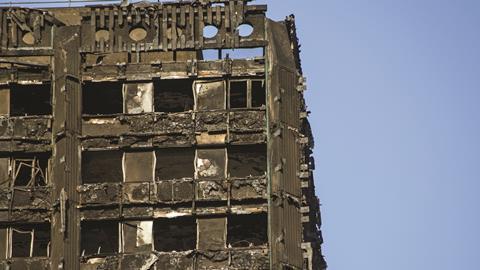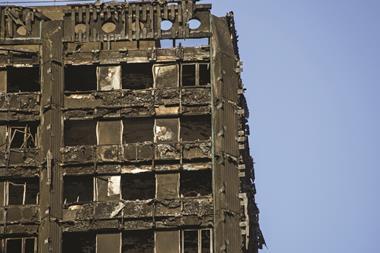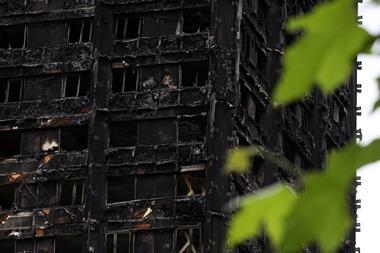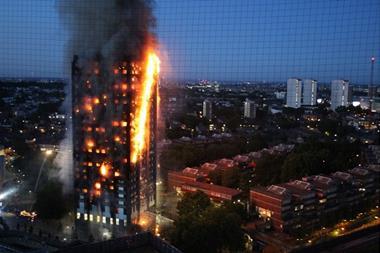The risk culture of the construction sector and ambiguous regulation are major fire safety problems, according to the independent review of the Grenfell high-rise disaster
In June last year the horrific Grenfell tower blaze in London killed 71 people in the heart of the city. Popular outrage was expressed, and institutions were compelled to act.
“This tragic incident should not have happened in our country in the 21st century,” wrote Dame Judith Hackitt, head of the independent review commissioned by the UK government and published on 18 December.
It became clear, the “Building a Safer Future” report confirms, that severe missteps had been made towards construction, on a national level, which compromised the safety of residents in high-rise residential buildings.
The fire in the Grenfell tower was caused by the building’s exterior cladding, which had also been used (and tested) on plenty of other properties across the country. The aluminium component of the outside cladding did not meet the required standards, although it had only been added recently as part of the block’s refurbishment.
“The current regulatory system for ensuring fire safety in high-rise and complex buildings is not fit for purpose,” the government report found. “What is being designed is not what is being built and there is a lack of robust change control.”
The regulatory system is too vague, the independent review reported, especially in the case of sub-contracting, and can easily be twisted to cut costs or save time. The lack of an objective third party overseeing the complete implementation of rules and standards further exposes the British construction industry to severe risks.
Desktop studies
“Testing how materials perform in fire takes time and is expensive,” noted Tom Roche, a senior consultant for codes and standards at FM Global, a mutual insurer using an engineering approach to the commercial property and construction sectors. “The lack of control and management is evident. You end up with lots of products on buildings we are not sure about,” Roche added.
The product testing mechanism seems to be the main issue because the risk model is not properly regulated, according to the Hackitt report.
Rather than testing material for construction in appropriate labs or fire testing facilities, desktop studies have become the norm – whereby an engineer looks at data from previous physical fire tests and, solely based on that, determines the safety of the material that is about to be used for construction.
The writers of the review warned against the increased use of desktop studies to assess the validity of construction material.
“The government should significantly restrict the use of desktop studies to approve changes to cladding and other systems,” the report stated.
Roche agreed: “You can’t extrapolate an orange into an apple just because they come from the same aisle of the supermarket. They do not taste the same. The same goes for cladding.”
Materials are made out of different components, variables, sizes and thickness. The properties of the same product can vary greatly depending on which context it is being used.
“You can’t judge large-scale performance of products from small tests,” emphasised Roche.
Moreover, desktop studies sit under a confidentiality umbrella. This means that if a desktop test has been approved for a certain material and afterwards another contractor does a physical fire test in which the material turns out not to be fire-resistant, they are not obliged by law to change the construction material used previously.
The report also found that there is a lack of meaningful sanctions, which discourages ethical behaviours, and that new regulations should be stipulated from a risk-based perspective.
“If I accept this material instead of that material, what are the risks?” asked Roche.
Grenfell seems to at least have made the industry more aware of the dangers around.
Roche confirmed that from a commercial point of view people are starting to do more in-depth risk assessments and asking the right questions. He also said that more diagnoses are being made for clients to check the materials from which their buildings are constructed.
“In the case of complex and high-risk buildings with complex ownership and occupancy models, a more rigorous risk-based process must be put in place to ensure that building integrity is maintained throughout the life cycle,” the Hackitt review concluded.
Risk culture in the construction industry has been identified as a problem, and so has the effectiveness of regulation in the UK. These things need to change if another Grenfell wants to be avoided, the report suggested. Steps in that direction are being taken, but as the report showed, there is still much to be done.
Hosted by comedian and actor Tom Allen, 34 Gold, 23 Silver and 22 Bronze awards were handed out across an amazing 34 categories recognising brilliance and innovation right across the breadth of UK general insurance.















































No comments yet